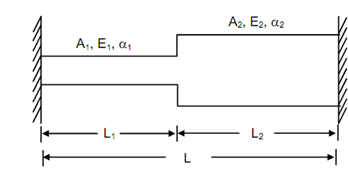Fully Restrained Stepped Bar:
If the bar were free to expand, it would have extended by a length ΔL given by
ΔL = L1 α1 ΔT + L2 α2 ΔT
= (L1 α1 + L2 α2) ΔT
Since the bar is fully restrained, P, the compressive force produced would have to produce a contraction equal to ΔL. Consider this force generate a stress σ1 in part 1 and σ2 in part 2 (these are the thermal stresses).
σ1 = P/A1 , σ2 = P/ A2
σ 1A1 =σ 2 A2 or σ = A1/A2 × σ1
σ1 shall produce a strain equal to σ1/ E1 and a change in length ΔL1 equal to σ1 L1 / E1
Likewise, σ2 shall produce a change in length ΔL2 equal to σ2 L2/ E2 . Therefore, the total change in length due to the application of force P will be equal to (ΔL1 + ΔL2 ) ,
We get,
ΔL1 + ΔL2 = σ 1L 1 / E1 + σ 2L2/ E2
But this should be equal to ΔL.
Therefore, σ 1L1 / E1 + σ2 L2/ E2 = ΔL = (L1 α1 + L2 α2 ) ΔT
But, 
σ2 = ( A1 / A2) σ1
∴ σ1 ((L1 / E1) + (L2A1)/(A2E2) = ΔT (L1 α1 + L2 α2 )
Hence,
∴ σ 1 = (ΔT E 1E 2A2(L1 α 1 + L 2α 2))/ ( A1 E1 L2 + A2 E2 L1 )
∴ σ 2 = (ΔT E 1E 2A2(L1 α 1 + L 2α 2))/ ( A1 E1 L2 + A2 E2 L1 )

Figure
Herein, we have assumed that the two parts of the bar are build of two different materials. Rather, if the total bar is of a single material of Young's Modulus E and coefficient of linear expansion α,
E1 = E2 = E and α1 = α2 = α
Then σ1 and σ2 decrease to
σ1 = (ΔT E A2 α L ) / (A1 L2 + A2 L1)
σ2 = ΔT E A α L / (A1 L2 + A2 L1)
Furthermore, if the cross-section is uniform throughout (A1 = A2 = A), both the above expressions decrease to
σ1 = σ2 =σ = E α ΔT
a result which we have already derived for uniform bars.